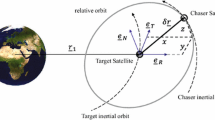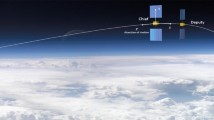Abstract
Satellite formation flight missions have long durations, so long-term perturbation effects (such as the J 2 effect) must be countered to maintain the formation. One possible approach to this problem is to affix a small reflective surface (called a “solar wing”) to the satellite: solar radiation pressure can then be harnessed to maintain formation flight. In this paper a full dynamic model for the long-term relative motion of formation flight is formulated, and an optimal solar wing steering law is devised for the formation-keeping problem. A numerical example is given to illustrate the approach.
Similar content being viewed by others
References
CHANDLER, LYNN “Scientists Delighted by First Images from EO-1 Satellite,” NASA News Archive, Release No: 00-151, December 19, 2000.
DAVID, L. “Researchers Anticipate Revolution in Nanosatellites,” Space News, September 13, 1999.
WILLIAMS, TREVOR W. and WANG, Z. “Uses of Solar Radiation Pressure for Satellite Formation Flight,” International Journal of Robust and Nonlinear Control, Vol. 12, Issue No. 2/3, February–March 2002, pp. 163–183.
SCHAUB, HANSPETER and ALFRIEND, KYLE T. “J 2 Invariant Reference Orbits for Spacecraft Formations,” Celestial Mechanics and Dynamical Astronomy, Vol. 79, 2001, pp. 77–95.
WANG, Z. “Dynamic Analysis of Satellite Formation Flight Using Solar Radiation Pressure,” Ph.D. Dissertation, University of Cincinnati, 2001.
SCHAUB, HANSPETER, VADALI, SRINIVAS R., and ALFRIEND, KYLE T. “Spacecraft Formation Flying Control Using Mean Orbit Elements,” The Journal of the Astronautical Sciences, Vol. 48, No. 1, 2000, pp. 69–87.
TAN, ZHAOZHI, BAINUM, PETER M., and STRONG, AVAINE “The Implementation of Maintaining Constant Distance Between Satellites in Elliptic Orbits,” presented as paper AAS 00-141 at the AAS/AIAA Space Flight Mechanics Meeting, Clearwater, Florida, Jan. 23–26, 2000.
SCHAUB, HANSPETER, ALFRIEND, KYLE T. “Hybrid Cartesian and Orbit Element Feedback Law for Formation Flying Spacecraft,” Journal of Guidance, Control and Dynamics, Vol. 25, No. 2, March–April 2002, pp. 387–393.
PRUSSING, J.E. and CONWAY, B.A. Orbital Mechanics, Oxford University Press, 1993.
MCINNES, C.R. Solar Sailing: Technology, Dynamics and Mission Applications, Springer-Praxis, Chichester, UK, 1999.
World Wide Web, URL: http://sec.gsfc.nasa.gov/magmulti.htm.
SCHAUB, HANSPETER and ALFRIEND, KYLE T. “Impulsive Feedback Control to Establish Specific Mean Orbit Elements of Spacecraft Formations,” Journal of Guidance, Control and Dynamics, Vol. 24, July–Aug. 2001, pp. 739–745.
VALLADO, D. Fundamentals of Astrodynamics and Applications, Microcosm Press, 2001.
Author information
Authors and Affiliations
Corresponding author
Additional information
A preliminary version was presented as paper AAS 02-187 at the AAS/AIAA Space Flight Mechanics Meeting, San Antonio, TX, January 27–31, 2002.
Rights and permissions
About this article
Cite this article
Wang, ZS., Williams, T. Solar Wing Steering Law for Satellite Formation Flight. J of Astronaut Sci 51, 227–246 (2003). https://doi.org/10.1007/BF03546310
Published:
Issue Date:
DOI: https://doi.org/10.1007/BF03546310




